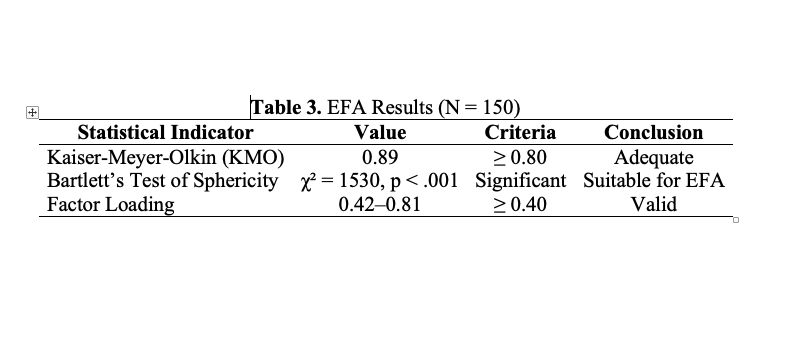Development of a Psychometric Instrument for Creativity Potential and Art Appreciation
https://doi.org/10.51574/jrip.v5i3.3899
Keywords:
creativity potential, art appreciation, instrument development, arts education, Psychometric analysisAbstract
This study aims to develop a valid and reliable instrument to measure creativity potential and art appreciation among students enrolled in the Arts and Culture Teacher Professional Education Program (PPG). The research was driven by the limited availability of assessment tools that comprehensively measure non-technical competencies, particularly creative thinking and aesthetic responsiveness, which are essential components in arts education. Employing a Research and Development (R&D) approach, this study adopted a modified Borg and Gall model consisting of seven stages, including needs analysis, blueprint formulation, item development, expert judgment for content validation, pilot testing, revisions, and large-scale field testing. Data were collected using a Likert-scale questionnaire and performance-based assessment tasks. Content validity was analyzed using Aiken’s V, while construct validity was tested through Exploratory Factor Analysis (EFA) and Confirmatory Factor Analysis (CFA). Reliability was established using Cronbach’s Alpha, McDonald’s Omega, and Intraclass Correlation Coefficient (ICC). The findings confirmed that the developed instrument met strong psychometric standards, with factor loadings aligned with theories of creativity and contemporary aesthetics. The instrument effectively captures five dimensions of creativity (fluency, flexibility, originality, elaboration, and creative self-efficacy) and five dimensions of art appreciation (formal perception, interpretation, evaluation, transformational reflection, and tolerance of ambiguity). This instrument can serve as a diagnostic and evaluative tool and provide pedagogical insights for enhancing creative and reflective learning in arts education.
Downloads
References
Abulela, M. A. A., et al. (2024). Development and initial validation of a Creative Self-Efficacy (CSE) scale for undergraduates. Frontiers in Education, 9, 1306532. https://doi.org/10.3389/feduc.2023.1306532
Amabile, T. M., & Pratt, M. G. (2016). The dynamic componential model of creativity and innovation in organizations: Making progress, making meaning. Research in Organizational Behavior, 36, 157–183. https://doi.org/10.1016/j.riob.2016.10.001
Beaty, R. E., & Kenett, Y. N. (2023). Associative thinking at the core of creativity. Trends in Cognitive Sciences, 27(7), 671–683. https://doi.org/10.1016/j.tics.2023.04.004
Capron Puozzo, I., & Audrin, C. (2021). Improving self-efficacy and creative self-efficacy to foster creativity and learning in schools. Thinking Skills and Creativity, 42, 100965. https://doi.org/10.1016/j.tsc.2021.100965
Izadi-Avanji, F. S., Zamani, N., Azizi-Fini, I., & Mohammadnejad, E. (2024). Development and psychometric testing of the Aesthetics of Everyday Life Scale in Aging (AELSA). BMC geriatrics, 24(1), 259.
Christensen, A. P., Cardillo, E. R., & Chatterjee, A. (2023). Aesthetic cognitivism: A review and an empirical agenda. Psychology of Aesthetics, Creativity, and the Arts, 17(S1), 26–43. https://doi.org/10.1037/aca0000537
Fekete, A., Pelowski, M., Specker, E., Brieber, D., Rosenberg, R., & Leder, H. (2023). The Vienna Art Picture System (VAPS): A dataset of 999 paintings and subjective ratings for art and aesthetics research. Psychology of Aesthetics, Creativity, and the Arts, 17(5), 660–671. https://doi.org/10.1037/aca0000460
García-Madruga, J. A., Lupiáñez, J., & Navarro, E. (2025). Development and validation of the Scale of Aesthetics and Creativity in Chess (SACC). Frontiers in Psychology, 16, 1456.
Iosifyan, M. (2021). Theory of mind increases aesthetic appreciation in visual arts. Psychology of Aesthetics, Creativity, and the Arts, 15(3), 451–461. https://doi.org/10.1037/aca0000301
Kang, S., & Kim, J. (2017). Evaluating students’ performance in responding to art: Development and validation of an Art Criticism Assessment Rubric (ACAR). British Journal of Educational Studies, 65(4), 489–507.
Karwowski, M., Lebuda, I., & Wiśniewska, E. (2024). Development and initial validation of a creative self-efficacy scale for undergraduates. Frontiers in Education, 9, 223.
Li, F., Wang, L., & Sun, J. (2023). Construction and validation of the Postgraduate Research Innovation Ability Scale. Frontiers in Psychology, 14, 445.
Li, F., et al. (2024). Creativity self-assessments in design education: A systematic review. Thinking Skills and Creativity, 52, 101350. https://doi.org/10.1016/j.tsc.2024.101350
Liu, D., Wu, C., Meng, Y., & Dang, J. (2025). How self-belief in creativity and well-being is associated with life satisfaction, meaning in life, and psychological richness. Journal of Intelligence, 13(3), 25. https://doi.org/10.3390/jintelligence13030025
Liu, M., Pei, Y., & Pang, W. (2025). Exploring the Interplay Between Creative Self-Efficacy, Mindset, and Creativity in Response to Negative Feedback. Behavioral Sciences, 15(6), 806.
Mattheiss, J., & Herrmann, H. (2024). Fostering appreciation of beauty in education. Frontiers in Education, 9, 1381101. https://doi.org/10.3389/feduc.2024.1381101
Muth, C., Carbon, C. C., & Leder, H. (2023). Aesthetic Processing Preference Scale (APPS): Development and validation. Psychology of Aesthetics, Creativity, and the Arts, 17(3), 432–446.
Pei, X., & Cao, Y. (2025). Aesthetic appreciation is different: Aesthetic pleasure in architectural aesthetics. Buildings, 15(4), 543. https://doi.org/10.3390/buildings15040543
Pelowski, M., Markey, P. S., Forster, M., Gerger, G., & Leder, H. (2017). Move me, astonish me... delight my eyes and brain: The Vienna Integrated Model of Art Perception (VIMAP) and its application to empirical aesthetics. Physics of Life Reviews, 21, 80–125. https://doi.org/10.1016/j.plrev.2017.02.003
Pizzolante, M., Pelowski, M., Demmer, T. R., Bartolotta, S., Sarcinella, E. D., Gaggioli, A., & Chirico, A. (2024). Aesthetic experiences and their transformative power: A systematic review. Frontiers in Psychology, 15, 1328449. https://doi.org/10.3389/fpsyg.2024.1328449
Primi, C., Benedetti, D., & Donati, M. (2021). Development and validation of an inventory to assess traits of creative potential (TCPQ-12). Frontiers in Psychology, 12, 678901.
Sawada, K., et al. (2024). Appreciation processing evoking feelings of being moved and inspiration: Awe and meaning-making. Journal of Aesthetics & Creativity Research, 2(1). https://doi.org/10.1016/j.jacr.2024.100025
Tao, Y., Chen, S., Li, J., & Zhang, Y. (2024). The influence of trait and state creative self-efficacy on creative behavior. Frontiers in Psychology, 15, 1398257. https://doi.org/10.3389/fpsyg.2024.1398257

Downloads
Published
How to Cite
Issue
Section
License
Copyright (c) 2025 E.W Suprihatin Dyah Pratamawati, Sri Rahayuningsih, Farah Damia Mohd Nasir

This work is licensed under a Creative Commons Attribution-ShareAlike 4.0 International License.












